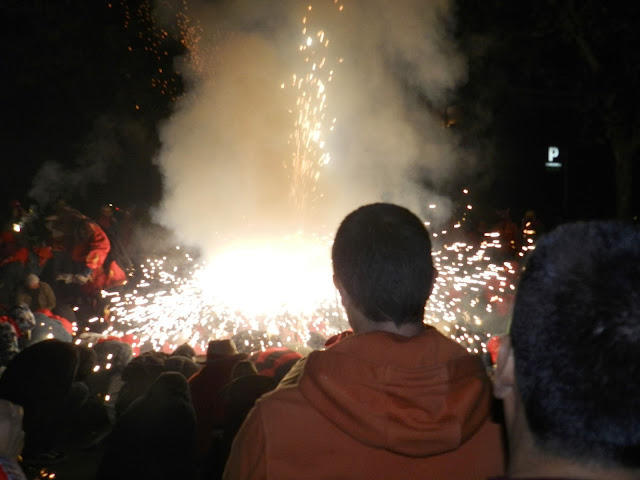 |
| CAFETERIA LA CATEDRAL |
 |
| TORRES HUMANAS |
 |
he Castell[edit]
A castell is considered a success when stages of its assembling and disassembling, can be done in complete succession. The assembly is complete once all castellers have climbed into their designated places, and the enxaneta climbs into place at the top and raises one hand with four fingers erect, in a gesture said to symbolize the stripes of the Catalan flag. The enxaneta then climbs down the other side of the castell, after which the remaining levels of castellers descend in highest-to-lowest order until all have reached safety.
Aside from the people who climb to form the upper parts of the tower, others are needed to form the pinya, or bottom base of the castell, to sustain its weight. Members of the pinya (most often men) [2] also act as a 'safety net' if the tower structure collapses, cushioning the fall of people from the upper levels. It is not uncommon—when not in competitions—for other colles to assist in the pinya when a small colla is attempting a specially demanding structure in terms of people needed.
The castell is built in two phases. First, the pinya—the base of the tower—is formed. People forming higher levels of the tower move to a position from which they can easily get to their place in the tower. This is done slowly and carefully, [3] and as subsequent base levels are completed the castellers in the pinya determine if their base is solid enough for construction to continue. Then, when the signal to proceed is given, bands begin to play the traditional Toc de Castells music as a hush comes over spectators of the event. The upper layers of the tower are built as quickly as possible in order to put minimal strain on the lower castellers, who bear most of the weight of the castell. The disassembly of the castell, done amidst the cheering of the crowd, is often the most treacherous stage of the event.
There is a form of the Castell, generally referred to as 'rising', in which each successive layer is added from the bottom by lifting the castell into the air, stage by stage. It is held that this form takes even more skill and strength and a great deal of practice. Four levels complete have been observed and five attempted, but it is said [who?] that the record is six or perhaps seven.
|




























 |
Correfocs (Catalan pronunciation: [ˌkorəˈfɔks], Western Catalan: [ˌkoreˈfɔks]); literally in English "fire-runs") are among the most striking features present in Catalan festivals. In thecorrefoc, a group of individuals will dress as devils and light fireworks. While dancing to the drums of a traditional gralla, they will set off their fireworks among crowds of spectators.
The correfoc can come in many forms. Some are simple parades using fireworks and effigies of the devil. In Sitges, it is common for a crowd to line a street, while participants run through a tunnel of fireworks. In Barcelona and Tarragona, the correfoc is run during the Festival of La Mercè, in September.
Another typical Catalan folkloric expression of this sort takes place in L'Arboç. The highlight of the village's feast is the Carretillada. In the evening of the feast day, the town square is made to look like Hell. For nearly half an hour, "devils" burn their carretilles (carts), jumping around ceaselessly, while a large "sceptre of Lucifer" and the "pitchfork of the Diablessa (she-devil)" shoot fire-jets and other pyrotechnics. Every year, the carretillada is a bit different, because the 'colla' (group) does not give up novelties that are added each year to add to the spectacle.
|
 |
| CORREFOCS |
 |
| CORREFOCS |
 |
| CORREFOCS |
 |
| CORREFOCS |
 |
| CORREFOCS |
 |
| Add caption |
 |
| CORREFOCS |
CON EL ALCALDE JORDI, TRABAJA UN COLOMBIANO DE PEREIRA
QUE SE LLAMA JOHN JAIRO CASTANO, (34) 617-904609

















































































No comments:
Post a Comment